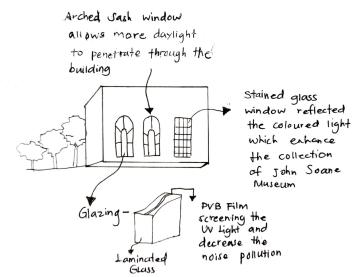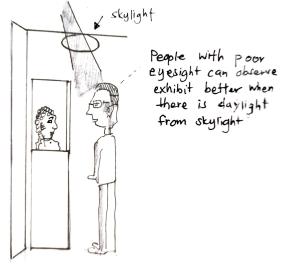
5 minute read
Daylight
by Noah
07
DAYLIGHT Research by Helen Lim Xin Ying
Advertisement
Skylight
Skylight is a kind of daylighting form of the building that are installed on the roof.Skylight receive daylight with large and uniform lighting depth at the same time provide a broad and clear view for the interior.For instance,skylight in John Soane’s museum comes with several sizes and shapes in various colour such as light yellow, white and dark yellow which presenting different colors at different times bringing wonderful visual enjoyment for the visitors.There is a handkerchief dome with skylight that is floating in the middle of the breakfast room, there are convex mirror placed at each corner of the handkerchief dome which helps to reflect the coloured light from the stained glass fitted on the skylight.Then,John Soane’s private study and dressing room is illuminated by a skylight that filled with yellow glass so the it change the colour temperarure which will let the space looks warm.
The Soane museum’s architecture office and picture room consist of skylight filled with clear glass to allows daylight penetrates and make the exhibit and important picture restore its original colours.These skylight is similar to mirror as it makes the room look spacious and bigger.
Window Openings
Windows are essential because they can change people’s perception of the scenery outside the window in various ways and can bring light in to let the interior look more spacious.For instance,there are window placed near staircase in John Soane’s museum mainly for daylight to shine on the picture and the exhibit and aware the people the weather outside.John Soane often used stained glass window to enhance his own collection such as sculpture and painting as light that penetrate through stained glass could enrich the color of exhibits.Then, he also used arched sash window as it is taller than normal window so it allows more daylight to enter the space.
Glazing
The glazing of a museum should come with double glazing, it needs to fulfil low emissivity coating which can filter out the Uv light so it can transmit daylight with no harmful effect.One of the glazing that suitable for museum is laminated glass as it has extremely high safety even if the glass is broken, the pvb film in the laminated glass will stick the broken glass so it can prevent the glass from hurting people.Then,the pvb film can decrease solar transmittance and screening the Uv light which avoid the exhibit from fading. Laminated glass has a good acoustic effect as the pvb film in the laminated glass can resist the spread of noise so that people will not be affected by external noise.
Transparency of the Wall
For the transparency of the wall,it can comes with various types such as curtain wall and translucent wall.Translucent wall is better as it is blocking the Uv light from entering and lower the heat from outside.For example, VCU Institute for Contemporary Art applied translucent wall as it reduces glare so people can benefit from daylight without suffering from glare.
Figure 2: Types of window in John soane museum

Figure 3:The translucent wall


Figure 4: Orientation of sun angle

Figure 5:Patient lives in room with daylight VS Patient lives in room with no daylight

Light level
The light level of daylight is approximately 15000 lux mix with sun.In a museum, the light level near the window could receive 1000 lux while the middle space only received 25-50 lux.
Orientation of sun angle
In a museum,the window should be placed at north or south side as both side gain less solar heat while the east and west side will receive strong radiation which makes the interior extremely hot. Therefore,window should placed at north or south to prevent the daylight to damage the exhibit from cracking and fading.
Work of Roger Ulrich
Based on Roger Ulrich’s research, he published a research report on how daylight cure patient in the medical environment.He investigated 46 patients in a 200 beds suburban hospital in Pennsylvania who underwent gallbladder surgery from 1972 to 1981. The patients were divided into 2 groups where one group could only see a wall from the ward and the other group could see daylight from the ward.The result is the patients who lives under daylight ward consume less painkillers and recover faster.By exposing to daylight, it helps patients relieve stress and enhance the positive effects of the immune system so that they can recover faster.
What is Uv light? Is it useful or harmful?
In my opinion Uv light is harmful.Uv light is the general term for radiation wavelength in the electromagnetic spectrum which invisible by human’s vision.Uv light do harmful to the exhibit as it will oxidize and deteriorate which will cause the exhibit to crack or deform. The reason why Uv light can change the color of exhibits and cause fading is that they actually change the chemical bonds of the exhibit.Uv light increases the surface temperature of exhibits which accelerate the rate of deterioration.
Is daylight good for museum?
Daylight is good for museum as it can restore the original colours of the exhibit. Compared with artificial light, people with poor eyesight can better observe exhibit under daylight.Daylight shining into the museum allows people inside to receive the weather outside at any time so they will not feel depressed. Daylight is a renewable source and it’s free.Since it is free, there is need to spend money on electricity bills.Then, the exposure of daylight will also improve people’s mood as daylight’s colour temperature ranges from 5000k-6000k which helps people to have good interest and be able to watch exhibits more attentively.Daylight can be a kind of wayfinding. When people are trapped or in an unfamiliar environment, daylight can help find the direction. Daylight is important as Stephen Kellert acknowledged that human’s happiness and health is related to biophilic design.He concluded that we are getting far away from nature world which causes us the ability to think and communicate.Therefore, daylight is essential for museum as it increase our concentration and let us think and communicate better.
Figure 6:Uv light causes the statue to crack

Figure 7:Skylight helps people with poor eyesight observe better











